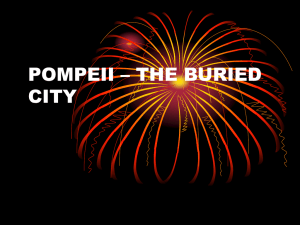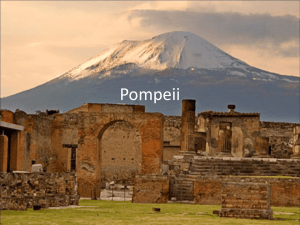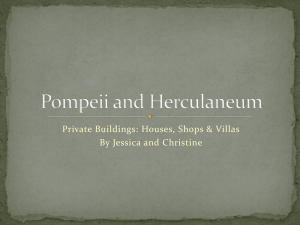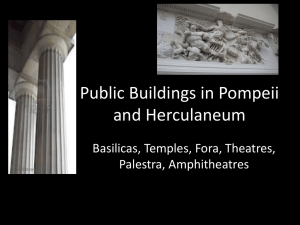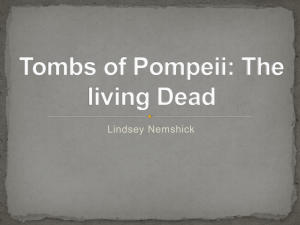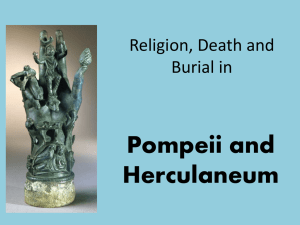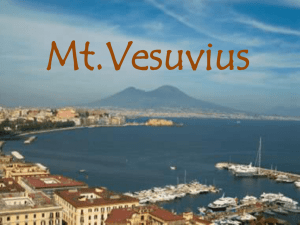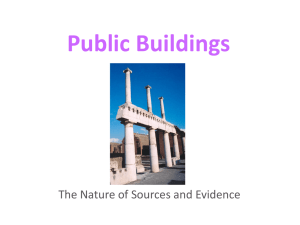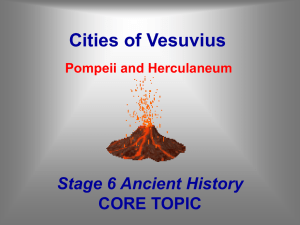POMPEII – THE BURIED CITY
advertisement
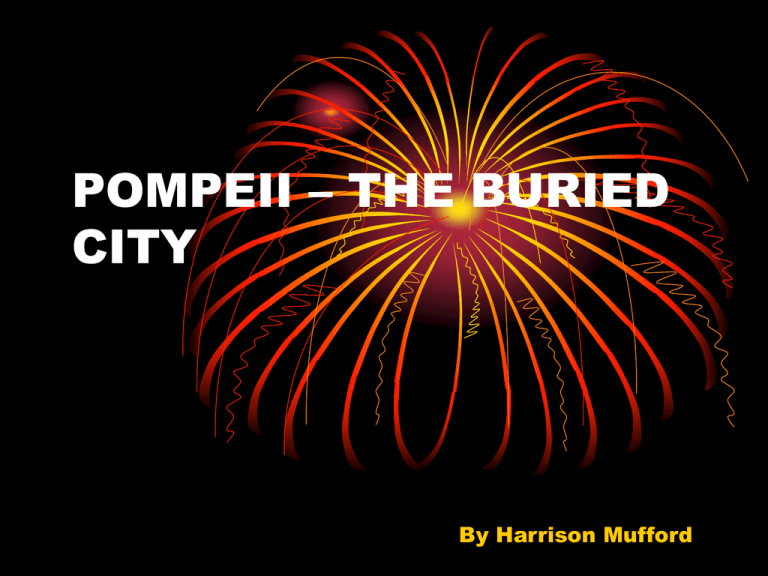
POMPEII – THE BURIED CITY By Harrison Mufford POMPEII • This is what Pompeii, Italy looked like at the time Mt. Vesuvius exploded. • The architecture was extremely beautiful in A.D. 79. The Floor Plan of the House of Menander The Interior of The House of Menander • Welcome to the house of Menander. • This house is one of the largest and most luxurious in Pompeii. • It occupies almost a whole city block. • This is the atrium or the front of the house. The Atrium • You can see in the left corner of the room a shrine to the Lares, the gods that protected the house. The Exterior of The House of Menander • This is the garden courtyard and outer dinning area. • As you can see they have restored the gardens in the centre courtyard. Menander’s Bath • This is a picture in Menander’s hot room in the private bath suit. Wall Paintings Inside the House of Menander The Forum of Pompeii • This is an Arial view of the Forum. • The main street came to an end at the Forum. • It was considered the pride of Pompeii. • The green surrounding buildings housed the government. • It was the center of government, religion and commerce. • It stretched several blocks. The Forum of Pompeii • The towering columns of the forum still stand today. • Once the heart of the city, this grand square was badly damaged by an earthquake in A.D. 62 and then burred by the eruption of Vesuvius. • It included long colonnades, statues of horsemen and a huge temple dedicated to Jupiter. The Architecture of the Forum • • As was typical of the time, most of the most important civic buildings at Pompeii - the municipal offices, the basilica (court-house), the principal temples (such as the Capitolium), and the macellum (market) - were located in or around the forum. Wall-paintings in one of the houses excavated illustrate scenes from the forum, such as bustling market-stalls set up in the colonnade fronting many of the forum buildings. Such evidence highlights the importance of this area in the everyday lives of the town's inhabitants Pompeii Bakery • • • The lava mills and the large woodburning oven identify these premises as a bakery. Each mill consists of two mill-stones, one stationary and one hollow and shaped like a funnel. The funnelshaped stone had slots, into which wooden levers could be inserted so that the stone could be rotated to grind the wheat. Each mill would have been operated either by manpower or with the help of a donkey or horse (in one bakery, the skeletons of several donkeys were discovered). In total, 33 bakeries have so far been found in Pompeii. Buying Bread • This is a wall painting of someone selling bread. • Loafs of bread are stacked up on the counter where the man is handing them out to the customers. • It is thought that the people of Pompeii bought their daily bread from bakeries rather than bake it themselves at home, since it was rare to find an oven in a home. The Forum Baths Interior Forum Bath Layout 1. 2. 3. 4. 5. 6. 7. 8. 9. 10. 11. 12. 13. 14. Men’s dressing room Men’s cold bath Men’s warm bath Men’s hot bath Gymnasium Bronze hot seats Basins Bath tub Furnaces for air and water temperature that service both men and woman's sides. Woman’s dressing room Women’s cold bath Women’s warm bath Women’s hot bath Open-air courtyard The Forum Baths • This is a wall painting of Venus on a seashell being escorted by cupid. It was discovered in 1952 in the forum bath. Attention to Details • This is an example of the original lettering around the giant marble basin “labrum.” The Ceiling of the Forum Baths • This is the room between the hot and cold baths. It has a stucco barrel vaulted ceiling and niches in the walls that are adorned with terra cotta. Pompeii volcano hole HARRISON MUFFORD
